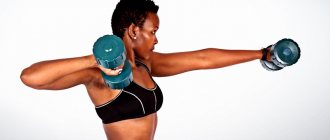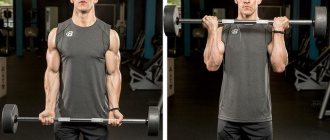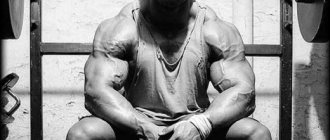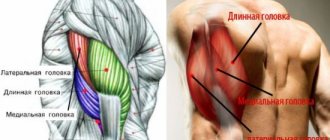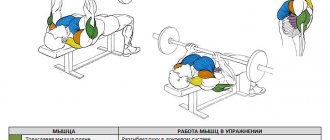How to properly train arm muscles
There are several secrets here:
- The growth of small muscles directly depends on the size of large ones
In order for the arm volume to grow by 2 cm, you need to add about 5 kg to your total weight.
It is impossible to weigh 60 kg with an arm volume of 50 cm. Such parameters are typical for people weighing 100-110 kg.
If you want big biceps and triceps, pump up your legs, back and chest!
- Less frequent workouts
In order for the arm muscles to steadily increase in volume, it is enough to train them 1-2 times a week.
Many people make the grave mistake of believing that small groups need little rest.
The fact is that the arms are indirectly loaded when pumping large muscles such as the chest and back, helping to perform the movement.
The triceps are involved in all pressing movements as you pump your chest and shoulders. Well, the biceps are responsible for traction while pumping the back muscles.
Excessive training leads to local overtraining, which results in a complete stunting of growth.
- Multi-joint exercises with free weights are the basis of the program.
It is the “base” with a barbell and dumbbells that promotes the production of testosterone, the main hormone that affects muscle growth.
Simultaneous training of biceps and triceps
Training biceps and triceps on the same day is effective for pumping them up, since these muscles are nearby and are antagonists. First, you should perform exercises for one muscle group, then for another:
- for beginners – for each muscle group – 3 exercises: basic – 1-2, isolating – 1;
- for advanced athletes - 4-5 exercises to work the muscle from different angles, without missing a single muscle fiber.
Basic exercises for triceps (triceps brachii muscle)
Perform 8-12 times in 4 approaches:
- close grip bench press;
- French bench press;
- French dumbbell press with one arm while seated.
Close grip bench press
Important. When loading the triceps brachii muscle, the front part of the deltoid and upper chest are involved. When bench pressing, you need to take a narrower grip so that you pay attention specifically to the triceps, and the load is not distributed between the three muscles. A grip that is too narrow can lead to injury because the exercise will be uncomfortable.
How to do a bench press:
- lie down on a horizontal bench;
- place the bar strictly above your head;
- place the brushes behind the fingerboard;
- ensure close contact of the head and shoulders with the surface of the bench;
- place your feet on the floor;
- remove the projectile from the racks and slowly lower it to the bottom of the chest, without hitting it with the chest;
- do not hold the barbell close to your chest (just touch it) and move the barbell away from your head;
- do not arch your back to avoid spinal injury.
It is important to know. Do not pull the barbell to eye level to avoid injury. The biceps will be activated more if the head is positioned below the level of the hips. When bench pressing, you should work your elbow joints to train your triceps. If you train your chest, then your shoulders work.
Basic biceps exercises
Perform biceps curls 8-12 times in 4 sets:
- standing barbells;
- standing dumbbells;
- barbells with a reverse grip.
How to pump up biceps for beginner athletes so as not to “clog” them? There is no need to do a large number of approaches and in each of them force the biceps to work additionally, more isolated. In any exercise, the arms and biceps are always involved, so you should not overdo it. Beginners need one or two basic exercises per week to train their biceps. If you train them more often, they will not be able to recover, and therefore grow.
Previously, we wrote about how to pump up your shoulders at home and recommended bookmarking the article.
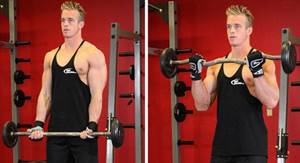
Standing biceps curl
How to properly lift a barbell while standing:
- to load the outer head, make a wide grip, to load the inner head, use a narrow grip;
- do not help with your body when lifting the barbell;
- lower the barbell slowly, controlling the movement, excluding throwing;
- press your elbows to the body, carry out the movement in the elbow joint;
- Do not bend your wrists to avoid injury. If there is discomfort in the wrists, use bandages and switch from a straight bar to a curved one.
It is important to know. When mastering heavier weights, slight cheating is allowed in the last 2-3 repetitions and two approaches for more advanced athletes. It is not advisable for beginners to use the cheating technique because of its risk of injury: the ligaments are overloaded. In cheating, a slight push and help from the legs and body are allowed. If you have problems with your knees and lower back, then cheating cannot be used.
For biceps, perform dumbbell lifts while standing and on an incline bench, pulling with a reverse grip, as well as barbell lifts on a Scott bench. This excludes the help of all other muscle groups, as well as cheating in order to concentrate on working the biceps.
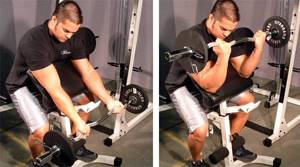
Lifting the barbell on a Scott bench
Technique for performing barbell lifts on the Scott machine
- The height of the music rest is adjustable to ensure a straight torso when lifting the barbell. The torso should be in an upright and stable position.
- The EZ barbell or dumbbell is taken with an overhand grip. Sit on a Scott bench and press your upper arms tightly against the music stand to direct the load on your biceps. The barbell is lowered, and the arms are slightly bent at the elbows.
- After inhaling, hold your breath to maintain correct posture, tense your biceps and lift the barbell or dumbbells up.
- Exhale is done with the forearms in a vertical position. After a second stop and even more tension on the biceps, the barbell is lowered smoothly, without fully extending the arms at the end point in order to avoid injuries to the elbows and biceps ligaments.
- Take a short break and repeat the exercise.
Recommendations. To avoid injuring your elbow joints, you need to make sure that the music stand is tight enough. You can avoid injury and increase the effectiveness of the exercise by keeping your body stationary and stable.
We also recommend studying this topic:
Basic exercises for pumping up triceps in the gym
6392 0 0
Program for biceps and triceps
The biceps-triceps superset is a high-intensity technique combining two exercises into one. At the same time, they are performed alternately. For example: first, a dumbbell biceps curl is performed, then immediately a French press. After a 1-2 minute rest, the next series of exercises is performed. On one day the program may include:
- one basic exercise for each muscle group, repeating 8-12 times and performing 3 approaches: barbell curls, close-grip barbell press (lying);
- superset principle, repeating the exercise 8-12 times, performing 3-4 approaches: standing dumbbell lift for biceps, French dumbbell press with one hand (sitting);
- lifting the barbell with a reverse grip for the biceps with 10-12 repetitions and 3-4 approaches and an exercise for the triceps on the block with 10-15 repetitions and 3-4 approaches.
To avoid overtraining, supersets are performed no more than once a month; the rest of the time, the usual scheme is used. You can use the superset one more time to more actively fill the muscles with blood in the last isolation exercise.
Readers found these materials useful:
- Some of the coolest exercises for pumping up your arms
- A set of effective exercises for pumping up a girl’s arms
Exercises for the brachialis muscle
Many athletes ignore or are unaware of the brachialis muscle. And its development is needed for a more massive and impressive appearance of biceps and triceps. The biceps muscle takes up less space than the triceps and brachialis. Together with the biceps, the brachialis crosses the elbow joint and is involved in adducting the forearm to the shoulder, bending the arm at the elbow. It is located deep in the shoulder muscles, attached to the shoulder bone at one end and connected to the forearm on the other side. It does not participate in supination, but flexes the elbow joint.
When the arm is flexed (thumb pointing upward), the load is placed more on the brachialis rather than the biceps. If there is an imbalance between the development of the biceps and brachialis, then pain in the elbow joint may occur, limiting movement when pumping up the biceps.

Exercise for brachialis
In exercises for the brachialis, you can use hammer, reverse and spider grips, as well as overhead curls using the anatomical features of the position of the biceps: the closer they are to the head, the greater the load on the brachialis.
Exercises:
- lifting the barbell onto the biceps using a reverse grip;
- lifting dumbbells using a hammer grip;
- on the Scott bench, barbell curls;
- spider curls – bending the arms with the elbows resting.
Exercise program for phase No. 1
Exercises:
- No. 1. Cross your arms in a hammer style with dumbbells. First, warm-up exercises are performed for 10 repetitions - 2-3 approaches, then working exercises - 10 repetitions and 3 approaches.
Remember! Each muscle contraction requires a strong squeeze of the dumbbells. When lowering the dumbbells, you should fully extend your arms to warm up your lower biceps.
- No. 2. Bend your arms on a Scott bench using a barbell with a curved bar - 8 reps and 3 sets. The bar is lowered without fully straightening the arms (by 90%) to prevent injury.
- No. 3. Bend your arms in a standing position, using a straight barbell or with a curved bar, pause – 3 seconds, repetitions – 8, approaches – 2. The weight is lowered after the pause, and you can feel the muscles “burning”.
- No. 4. Extend the arms to the triceps using the torso (vertical block). Elbows are pressed to the body, muscles are tense at the lowest point for 1 second, repetitions - 12, approaches - 4.
- No. 5. Push-ups in a machine or on parallel bars with increasing weight in each approach. Repeat 8-12 times, 3 approaches.
- No. 6. Use a curved bar for extensions on an incline bench, repetitions - 15, approaches - 3. The weight should be lowered lower behind the head. It is not recommended to use heavy weights.
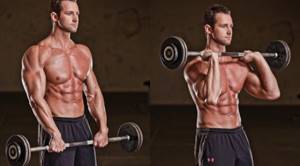
Reverse Grip Curl
We also recommend studying this topic:
Effective chest and biceps workout in one day
57008 0 5
Exercise program for phase No. 2
Exercises are performed with a 45-second break:
- No. 1. The arms are bent with a reverse grip, using a straight or curved bar. Reps – 10, sets – 5, break between sets – 10 seconds.
- No. 2. The arms are extended to the triceps using a cable. Repetitions – 10, approaches – 5. First, warm-up exercises are performed. The break between approaches is 10 seconds.
- No. 3. Arms are bent on a Scott bench or on a machine. Reps – 12, approaches – 3. The biceps are loaded, 6 repetitions are performed independently, 6 with the help of a partner.
- No. 4. Presses in the triceps machine. At first, do 8 heavy reps and 3 sets. There is a 3 second delay before the weight is slowly lowered. On the 4th set, the weight is set for 6 heavy negative reps.
- No. 5. Concentrately bend your arms with dumbbells using an incline bench. Reps – 8, approaches – 2.
- No. 6. Perform L-extensions for each arm. Reps – 15, approaches – 4.
- No. 7. While sitting, bend your arms with dumbbells, pause – 3 seconds, repetitions – 8, approaches – 2.
- No. 8. Using a narrow grip, do the EZ-bar press, reps – 8, sets – 4. The weight is lowered slowly towards the chin, without holding it on the chest.
Conclusion. By adding variety to your workouts, you can achieve an increase in muscle mass (biceps and triceps) by 1-1.2 kg per month without the use of proteins or other drugs.
Triceps. Home workout
First exercise. Standing French press. The body is straight, legs are shoulder-width apart. Hand position with dumbbells: elbow raised up, dumbbell behind back. The other hand belays the dumbbell, but does not support it. As you exhale, the arm gradually straightens at the elbow, while the hand rises from the dumbbells. The trainee focuses on the triceps. As you inhale, the arm bends again and the dumbbell is placed behind your back again.
Second exercise. Seated French press. Performed similarly to the first exercise. The trainee sits on a stool.
The third exercise is performed using a chair with wooden handrails. To perform it, the chair is placed opposite the sofa so that the feet are on the sofa, and the hands are pulled back and down to grasp the handrails of the chair, just as is done on the uneven bars. The point of the exercise is to bend/extend your arms while pushing.
Fourth exercise. A tape expander is attached to the home crossbar. The student turns his back to the horizontal bar. The body is straight, legs are shoulder-width apart. The exercise is performed with hands alternately. The arm is pulled back, as in a French press, but instead of a dumbbell, it holds a stretched expander. Then, with the elbow stationary, the arm straightens forward and upward.
Fifth exercise. Bending/extension of arms while lying down. Hands are placed narrowly. Otherwise, the main effort will be on the chest muscles. When performing the exercise, use a backpack with weights.
